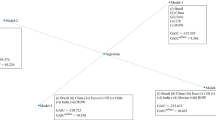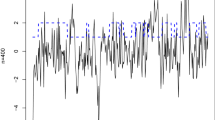Abstract
In this paper we propose a mixture global vector autoregressive model with exogenous variables to study country/region interdependencies that exist between national and international variables in the world economy. This model generalizes the linear one introduced by Pesaran et al. (Journal of Business & Economic Statistics 22(2):129–162, 2004) taking into account the possibility of contagion effects. Then, we give a complete solution of the above mixture global model, discuss its stability properties, and provide a likelihood-based analysis of the country/region specific models. Finally, a simulation experiment is presented to demonstrate the utility of the proposed algorithm and the nature of the problems under consideration.


Similar content being viewed by others
References
Ailliot, P., and Péne, F. (2015) Consistency of the maximum likelihood estimate for non-homogeneous Markov-switching models. ESAIM: Probability and Statistics 19, 268–292.
Balakrishnan, S., Wainwright, M.J., and Yu, B. (2017). Statistical guarantees for the EM algorithm: From population to sample-based analysis. The Annals of Statistics 45 (1), 77–120.
Benesch, T. (2001). The Baum-Welch algorithm for parameter estimation of Gaussian autoregressive mixture models. Journal of Mathematical Sciences 105 (6), 2515–2518.
Bibi, A., and Ghezal, A. (2017). Markov-switching bilinear GARCH models: Structure and estimation. Comm. Statistics: Theory and Methods 47 (2), 307–323.
Bougerol, P., and Picard, N. (1992). Strict stationarity of generalized autoregressive processes. Annals of Probability 20, 1714–1729.
Cavicchioli, M. (2016a). Weak VARMA representations of regime-switching state-space models. Statistical Papers 57, 705–720.
Cavicchioli M. (2016b). Statistical Analysis of Mixture Vector Autoregressive Models. Scandinavian Journal of Statistics 43 (4), 1192–1213.
Chrétien, S., and Hero, A.O. (2008). On EM algorithms and their proximal generalizations. ESAIM: Probability and Statistics 12, 308–326.
De Bandt, O., and Hartmann, P. (2000). Systemic risk: a survey. Working paper no. 35, European Central Bank, Frankfurt, Germany.
Dempster, A.P., Laird, N.M., and Rubin, D.B. (1977). Maximum likelihood from incomplete data via the EM algorithm. J. R. Stat. Soc. Ser. B. Stat. Methodol. 39 (1), 1–38.
Douc, R., Moulines, E., and Ryden, T. (2004). Asymptotic properties of the maximum likelihood estimator in autoregressive models with Markov regime. Annals of Statistics 32, 2254–2304.
Fong, P.W., Li, W.K., Yau, C.W., and Wong, C.S. (2004). On a mixture vector autoregressive model. Research Report no. 369, Department of Statistics and Actuarial Science, University of Hong Kong, Hong Kong, China.
Fong, P.W., Li, W.K., Yau, C.W., and Wong, C.S. (2007). On a mixture vector autoregressive model. The Canadian Journal of Statistics 35 (1), 135–150.
Francq, C., and Zakoïan, J.M. (2001). Stationarity of multivariate Markov switching ARMA models. Journal of Econometrics 102, 339–364.
Francq, C., and Zakoïan, J.M. (2002). Autocovariance structure of powers of switching-regime ARMA processes. ESAIM: Probability and Statistics 6, 259–270.
Ghezal, A. (2023). A doubly Markov switching AR model: Some probabilistic properties and strong consistency. Journal of Mathematical Sciences, https://doi.org/10.1007/s10958-023-06262-y.
Hu, Y., and Schennach, S.M. (2008). Instrumental variable treatment of nonclassical measurement error models. Econometrica 76 (1), 195–216.
Karabutov, N.N., and Feklin, V.G. (2016). Adaptive identification of systems with distributed lags. Journal of Mathematical Sciences 216, 649–666.
Kasahara, H., and Shimotsu, K. (2019). Asymptotic properties of the maximum likelihood estimator in regime switching econometric models. Journal of Econometrics 208, 442–467.
Kiefer, N.M. (1978). Discrete parameter variation: Efficient estimation of a switching regression model. Econometrica 46, 427–434.
Krolzig, H.M. (1997). Markov Switching Vector Autoregressions: Modelling, Statistical Inference and Application to Business Cycle Analysis. Springer-Verlag, Berlin-Heidelberg-New York.
Li, X., Safikhani, A., and Shojaie, A. (2022). Estimation of high-dimensional Markov-switching VAR models with an approximate EM algorithm. arXiv:2210.07456
Lin, W., Feng, R., and Li, H. (2015). Regularization methods for high-dimensional instrumental variables regressions with an application to genetical genomics. Journal Amer. Stat. Assoc. 110 (509), 270–288.
Lütkepohl, H. (1991). Introduction to Multiple Time Series Analysis. Springer Verlag, Berlin-Heidelberg-New York.
Ng, S.K., Krishnan, T., and Mc Lachlan, G.J. (2012). The EM algorithm. in: Handbook of Computational Statistics, Springer Verlag, Berlin-Heidelberg, 139–172.
Pesaran, M.H., Schuermann, T., and Weiner, S.M. (2004). Modeling regional interdependencies using a global error-correcting macroeconomic model. Journal of Business & Economic Statistics 22 (2), 129–162.
Pesaran, M.H., and Pick, A. (2007). Econometric issues in the analysis of contagion. Journal of Economic Dynamics and Control 31 (4), 1245–1277.
Qu, Z., Zhuo, F. (2021). Likelihood ratio based tests for Markov regime switching. The Review of Economic Studies 88 (2), 937–968.
Windmeijer, F., Liang, X., Hartwig, F.P., and Bowden, J. (2021). The confidence interval method for selecting valid instrumental variables. Journal Royal Stat. Soc. Ser. B. Stat Methodol. 83, 752–776.
Zhao, R., Li, Y., and Sun, Y. (2020). Statistical convergence of the EM algorithm on Gaussian mixture models. Electronic Journal of Statistics 14 (1), 632–660.
Acknowledgements
The author is grateful to the Editor in Chief, Professor Alexey Karapetyants, the Guest Associate Editor, Professor Andreeva Tatiana and the three anonymous referees for their very useful suggestions and remarks which were most valuable for improvement of the final version of the paper.
Funding
This work is financially supported by a research grant (FAR 2022) of the University of Modena and Reggio E., Italy.
Author information
Authors and Affiliations
Corresponding author
Ethics declarations
Compliance with Ethical Standards
Not applicable
Conflict of interest
The author declares no competing interests.
Appendix
Appendix
Treating (weakly) exogenous variables. The instrumental variable (IV) estimation is a general technique to handle problems associated with (weak) exogeneity. More precisely, IV is used when an explanatory variable of interest is correlated with the error term, in which case the standard estimation methods give biased results. Even in the simple univariate case, the choice of IV is not easy to make and it depends on the field of application. A simple check is to compute the linear correlation of IV with the suspected variable, and its correlation with the dependent variable. If the linear correlation is weak, then expect results of poor reliability, if the sample is not very large. The IV is correlated with \({\textbf{x}}_{it}^{*}\), but uncorrelated with the model error term \({\varvec{\epsilon }}_{it}^{(m)}\) by assumption or by construction. IV is used to replace the problematic variable \({\textbf{x}}_{it}^{*}\). More formally, the IV \({\textbf{v}}_{it}\) for the variable of concern \({\textbf{x}}_{it}^{*}\) satisfies \({\text {cov}} ({\textbf{v}}_{it}, {\textbf{x}}_{it}^{*}) \ne {\varvec{0}}\), \({\text {cov}} ({\textbf{v}}_{it}, {\varvec{\epsilon }}_{it}^{(m)}) = {\varvec{0}}\), and also it is not correlated with any unobservable factors influencing the dependent variable \({\textbf{x}}_{it}\). In the multivariate setting, the selection of IV seems to be more involved. Selecting IV requires three conditions: (1) IV is associated with the exposure; (2) IV only affects the outcome through the exposure; and (3) the effect of IV on the outcome is uncofounded. If the preceding rules are satisfied, the IV technique completely eliminates the simultaneous equation bias only in large samples. In finite samples, the larger the excess of observations over IV, the more the bias is reduced. General methodologies for selecting IVs in the multivariate setting have been provided by Hu and Schennach [17], Lin et al. [23], and Windmeijer et al. [29].
Proof of Theorem 4.1
The maximum likelihood estimates are obtained forming the Lagrangean
and setting the derivatives with respect to the elements of \({\varvec{\theta }}_{i m}\) and \(\pi _{i m}\) equal to zero (i.e., first order conditions FOC). From (8) we get
where \({\varvec{\epsilon }}_{i t}^{(m)}\) comes from (1). Then we obtain
Furthermore, from (8) we get
from which (13) follows. We also have
for \(j = 1, \dots , p_i\), and \({\varvec{\epsilon }}_{i t}^{(m)}\) comes from (1). Finally, we get
for \(h= 0, \dots , q_i\). From (A1)–(A3) we obtain the linear system
which can be written, more compactly, as
This gives (12). Finally, we have
where
Thus we obtain
Summing up over \(m = 1, \dots , M\) produces
hence
as in the last sentence of Theorem 4.1.
Rights and permissions
Springer Nature or its licensor (e.g. a society or other partner) holds exclusive rights to this article under a publishing agreement with the author(s) or other rightsholder(s); author self-archiving of the accepted manuscript version of this article is solely governed by the terms of such publishing agreement and applicable law.
About this article
Cite this article
Cavicchioli, M. LIKELIHOOD-BASED ANALYSIS IN MIXTURE GLOBAL VARs. J Math Sci 271, 341–353 (2023). https://doi.org/10.1007/s10958-023-06509-8
Accepted:
Published:
Issue Date:
DOI: https://doi.org/10.1007/s10958-023-06509-8
Keywords
- Maximum likelihood estimates
- Mixture global vector autoregressive model
- Nonlinear time series model
- Stability




